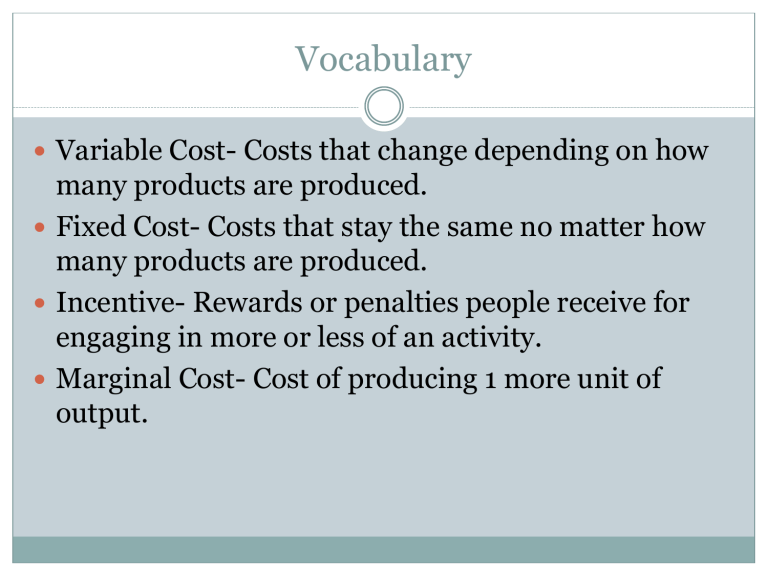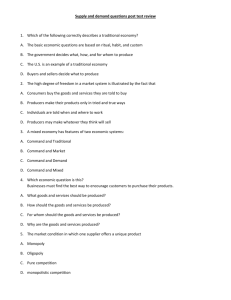Opportunity Cost

Vocabulary
Variable Cost- Costs that change depending on how many products are produced.
Fixed Cost- Costs that stay the same no matter how many products are produced.
Incentive- Rewards or penalties people receive for engaging in more or less of an activity.
Marginal Cost- Cost of producing 1 more unit of output.
Warm Up
What happens to the cost of an item when it is scarce?
Why is it that we must make economic choices?
What is a trade off?
Explain how to identify opportunity cost?
What is a benefit in regard to economic decision making?
What is the goal of producers?
What is the goal of consumers?
How do producers come up with a price?
What businesses or industries are is the State of NC known?
What kinds of things do producers have to pay for?
Think of the Factors of Production to help yourself answer the question.
Answer Me! Oh, please won’t someone answer me!
1.
A.
B.
C.
D.
Items that are scarce will likely be which of the following?
Cheap
Expensive
A renewable natural resource
An opportunity cost
Opportunity Cost
In order to run a business producers must meet the costs of the factors of production.
Immediate Gratification
Products (whether it is a need or a want) provide people with immediate gratification.
People receive immediate benefits from purchasing the product.
Variable costs
Costs that vary when the amount of products produced changes.
Water, ice, sugar, and lemons ($60)
Fixed costs
Costs that do not change regardless of how many goods are produced
Lemon squeezer, several large pitchers, a stirring spoon, a cooler to keep the lemonade cool, and the lemonade stand itself. ($80)
Total costs
Variable costs + fixed costs = total cost
Total cost = $140
Costs
Why do producers decide to sell something?
To make money
This is called an Incentive
Incentives motivate producers and consumers to take action
Ex: A producers sells something to make money, an incentive for a consumer to take an economic action would be a sale…Ex: 50% off
A producer will always have an incentive to sell one more unit if the cost of one more unit is less than the price of one more unit.
Marginal Costs
Cost of producing 1 additional unit of output. Suppose total cost to produce 120 glasses of lemonade is $140, and $140.50 to produce 121 glasses of lemonade. The marginal cost is…
.50 cents
Incentives
Marginal benefit
The amount of benefit that you get from selling more or less.
Your benefit can go down if you sell more…let’s see how
In order to see you must create a cost-benefit analysis graph
To create a graph you must compare the marginal costs and marginal benefits of your decision.
A cost-benefit analysis is an example of a economic model
Do you remember what the problem is with economic models?
Based on assumptions
Wages & Salary
Wages
Payments made by producers in exchange for one’s labor and time for the production of goods and services.
Generally tied to amount of hrs. worked
Salary
A set amount that the producer agrees to pay a laborer that is not tied to hours or specific production.
reflection
What is the difference between variable costs and fixed costs?
What is the goal of producers?
What is the incentive for producers to sell?
What is marginal cost?
What is the name of the economic model that compares the marginal costs and marginal benefits?
What is the problem with cost benefit analysis?
Activity
Pair up and go to the following website: http://www.econedlink.org/lessons/index.cfm?lesson=EM260
Activity
Create your own business.
After you have created your business plan and incentives answer the following questions on a separate sheet of paper:
1.
2.
Why is it better to have more positive “green” than negative
“red” incentives in your business plan?
How might this help your business to succeed?
3.
How might it be different to be motivated by negative incentives than positive incentives?
Partner with another group and discuss which incentives would be most effective and which would not. Write your names and responses on the separate sheet of paper and hand it in.
What is an incentive?







